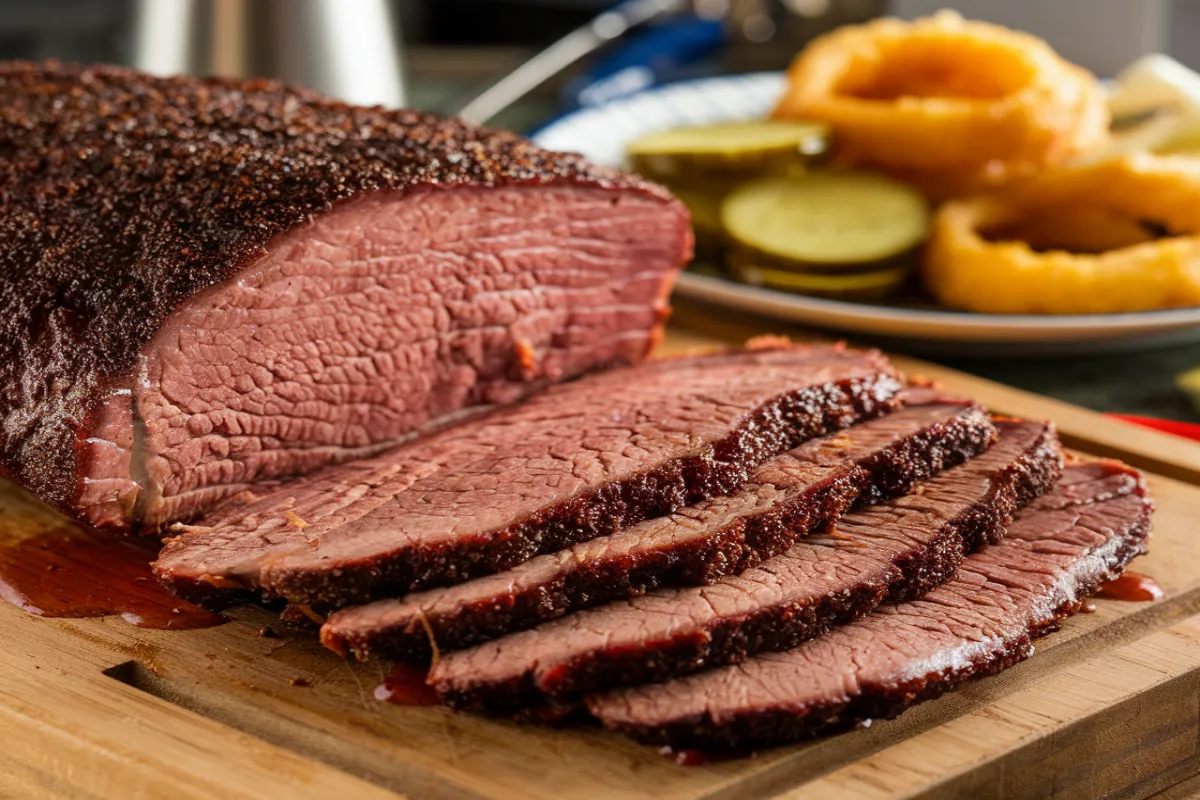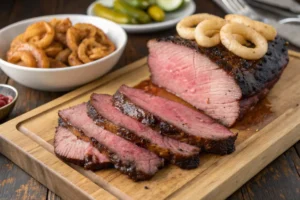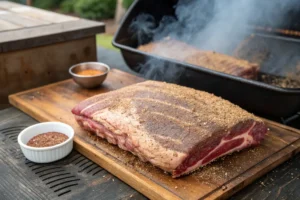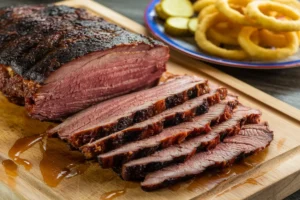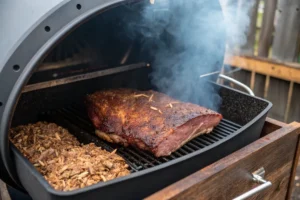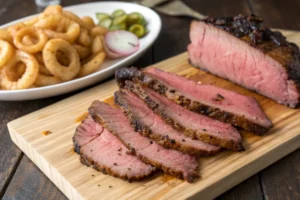Traeger brisket recipes – The Ultimate Guide to Smoking Brisket Like a Pro
When it comes to smoking brisket, few things can rival the incredible taste and texture you can achieve with a Traeger grill. This guide is for anyone who wants to master the art of cooking brisket on a Traeger, whether you’re a seasoned pitmaster or a beginner ready to take your grilling skills to the next level. Throughout this article, we’ll explore everything you need to know to create mouthwatering brisket, from choosing the perfect cut to understanding the science behind smoking it to perfection. By the end, you’ll feel confident in your ability to smoke brisket like a pro on your Traeger grill.
In this guide, we’ll take you through the key steps involved in preparing and smoking brisket using a Traeger grill. We’ll cover the essentials, like how to choose the right brisket cut, the best seasonings to use, and how to manage the temperature for that tender, melt-in-your-mouth finish.
Whether you’re planning to make a family feast, or you just want to experiment with something new, smoking brisket on a Traeger will be a game changer. The versatility of Traeger grills allows you to create different variations of brisket, all while maintaining the unique flavors that come from wood-fired cooking. So, fire up your Traeger and let’s dive into the world of brisket smoking!
Selecting the Right Brisket Cut for Traeger Recipes
One of the first and most crucial steps in creating the perfect smoked brisket is choosing the right cut. Brisket is a large, tough cut of beef that needs to be cooked slowly to break down the connective tissue and fat, which results in that tender, juicy finish everyone loves. However, not all brisket cuts are created equal, and it’s essential to pick the best one for your cooking method and desired flavor profile.
When selecting brisket for smoking on a Traeger, there are two main cuts to consider: flat and point. Let’s break them down and discuss their characteristics, so you can make the right choice.
Whole Brisket vs. Pre-Cut Brisket – Which Should You Choose?
Before diving into the differences between flat and point brisket, another consideration is whether to go with a whole brisket or a pre-cut one. Each option comes with its own set of advantages and challenges.
Whole Brisket
A whole brisket includes both the flat and point cuts, making it ideal if you’re looking for flexibility. The flat is leaner, while the point has more marbling, which translates into extra flavor. When smoked together, the two cuts create a balance of texture and juiciness. The downside? Whole briskets are typically heavier, costlier, and require more preparation time, as you’ll need to trim and season both parts. However, for those looking for the ultimate brisket experience, smoking a whole brisket on your Traeger is hard to beat.
Pre-Cut Brisket
If you want to save time, you can choose pre-cut brisket. This option gives you either the flat or the point, so you won’t have to deal with trimming or separating the cuts. The flat is a popular choice because it’s easier to manage and typically cooks faster. The point cut, however, is richer in flavor and perfect for anyone who loves a more fatty, flavorful brisket. Pre-cut brisket also tends to be more affordable, but you’ll miss out on the full experience of smoking a whole brisket.
When deciding between whole or pre-cut brisket, consider factors like the size of your grill, your budget, and how much time you’re willing to spend preparing the meat. Either way, both options can result in a delicious smoked brisket on a Traeger grill!
Preparing Brisket recipes for the Traeger Grill
Once you’ve selected your brisket and are ready to cook, the next crucial step is preparing it for the Traeger grill. Proper preparation is essential for ensuring that your brisket turns out tender, juicy, and full of flavor. Here’s a step-by-step guide to trimming your brisket, applying the perfect rub, and preparing it for a flawless smoke session.
Step-by-Step Guide on Trimming the Brisket
Trimming a brisket might seem like a daunting task, but it’s essential for achieving the best smoking results. The key is to remove the excess fat while leaving a good layer on the meat to provide flavor and moisture during the cooking process.
1. Trim the Fat Cap
Start by trimming the fat cap, the thick layer of fat on the top of the brisket. While it’s tempting to remove all of it, resist the urge. Leaving around ¼ inch of fat helps to maintain moisture throughout the smoking process and enhances the flavor. Too much fat, though, will result in greasy brisket, so be sure to trim it down to a manageable thickness.
2. Remove the Silver Skin
Underneath the fat cap, you’ll likely find a silvery membrane (silver skin) that doesn’t break down when cooked. This tough layer of connective tissue should be removed to ensure that your brisket is as tender as possible. Use a sharp knife to carefully lift the silver skin and pull it away from the meat.
3. Trim the Brisket’s Sides
Next, trim the sides of the brisket to create a uniform shape. This ensures even cooking and helps the meat to cook more evenly on the Traeger grill. Aim for a rectangular shape with straight edges, which will allow the heat and smoke to circulate around the meat evenly.
Applying the Perfect Brisket Rub for Maximum Flavor
The rub is an essential part of smoking brisket, as it adds both flavor and texture to the bark. While store-bought rubs can be convenient, making your own allows you to experiment with different spices and tailor the seasoning to your preferences.
Homemade vs. Store-Bought Rubs
Homemade rubs allow you to control the ingredients and adjust the seasonings to your taste. A simple combination of salt, pepper, garlic powder, onion powder, and paprika creates a well-rounded rub that enhances the natural flavor of the brisket. For a bolder flavor, you can add cumin, chili powder, or brown sugar.
Store-bought rubs are more convenient and come in a variety of flavors, from spicy to sweet, to suit different tastes. If you choose a store-bought rub, make sure it’s high-quality and free of artificial additives or preservatives.
How to Apply the Rub
To apply the rub, pat the brisket dry with paper towels first, ensuring the surface is free of excess moisture. Next, generously coat the brisket with your rub, pressing it into the meat to ensure it sticks. Be sure to cover all sides of the brisket, as the seasoning will help form that flavorful crust (bark) during the smoking process.
Tip: Season the Day Before
For maximum flavor penetration, it’s best to season your brisket the day before smoking. Allowing the rub to sit on the meat overnight lets the flavors meld and helps the spices to penetrate deeper into the meat. If you’re short on time, though, seasoning it at least an hour before smoking still yields great results.
The Importance of Resting the Brisket Before Smoking
Before placing your brisket on the Traeger grill, it’s important to let it rest at room temperature for about 30–60 minutes. While it may seem like an extra step, this is crucial for achieving even cooking and better results.
Why Resting is Essential
Resting the brisket before smoking allows the meat to come to an even temperature. If you place cold brisket directly on the grill, it can result in uneven cooking, causing parts of the meat to cook faster than others. By resting the brisket, the meat will cook more uniformly, which helps the collagen and fat break down evenly, resulting in a tender and juicy end product.
Traeger Brisket Smoking Basics
Now that your brisket is perfectly prepared, it’s time to dive into the smoking process. Traeger grills are renowned for their ability to produce consistent, even heat, making them ideal for low and slow cooking methods like smoking brisket. Let’s explore how to set up your Traeger for success and choose the best wood pellets to complement your brisket.
How Traeger Grills Work and Why They’re Great for Smoking Brisket
Traeger grills are known for their wood pellet system, which provides a consistent, flavorful smoke for low-and-slow cooking. Unlike traditional charcoal or gas grills, Traegers use wood pellets that are fed into a firepot, where they are ignited and produce both heat and smoke. The wood-fired flavor that Traeger grills impart is perfect for brisket, as the slow, steady heat breaks down the connective tissues and fat, while the smoke infuses the meat with rich, smoky flavor.
The temperature control on a Traeger is another reason they are perfect for smoking brisket. The digital controller allows you to set your desired temperature and maintain it throughout the entire cooking process, ensuring consistent results every time.
Setting Up Your Traeger Grill for Low and Slow Cooking
For smoking brisket, you’ll need to set your Traeger grill to a low and slow temperature. Begin by preheating your Traeger to 225°F (107°C). This temperature is perfect for allowing the brisket to cook slowly and absorb the smoky flavor from the wood pellets. Keep in mind that brisket is a tough cut of meat that requires extended cooking times to break down the collagen and fat, which is why low and slow is the way to go.
Choosing the Best Wood Pellets for Brisket
The type of wood pellets you use can greatly affect the flavor of your brisket. Some of the best wood choices for smoking brisket include:
- Hickory: Provides a strong, hearty smoke flavor that pairs well with beef.
- Oak: Offers a milder, more balanced smoke that complements the richness of brisket without overpowering it.
- Mesquite: Known for its bold, earthy flavor, mesquite works well if you prefer a stronger smokiness.
Feel free to experiment with different wood pellet blends to find the flavor that suits your preferences.
The 3/2/1 Brisket Method for Perfect Results
One of the most popular methods for smoking brisket is the 3/2/1 method, which helps ensure a perfectly tender and flavorful result. Here’s a breakdown of how it works:
- 3 Hours of Smoking (Unwrapped): Smoke the brisket for the first three hours without wrapping it. This allows the meat to form a flavorful bark while absorbing the smoke.
- 2 Hours of Smoking (Wrapped): After three hours, wrap the brisket in butcher paper or foil to retain moisture and continue cooking. This step prevents the brisket from drying out.
- 1 Hour of Resting (Unwrapped): Finally, unwrap the brisket and cook it for an additional hour to finish developing the crust and allowing the meat to rest.
This method is ideal for achieving that tender, juicy brisket with the perfect balance of bark and flavor.
Smoking Brisket Low and Slow – What Temperature Should You Use?
When smoking brisket, temperature control is key. The optimal temperature for smoking brisket on a Traeger is around 225°F (107°C). This low temperature allows the brisket to cook slowly, breaking down the collagen and fat to produce tender meat with a rich smoky flavor.
While some people choose to cook at 250°F (121°C) for slightly faster results, 225°F provides the best combination of tenderness and flavor, ensuring that your brisket is both juicy and flavorful.
Common Brisket Smoking Mistakes on the Traeger Grill
Smoking brisket on a Traeger grill offers an easy, convenient way to cook this classic cut of meat to perfection, but even with all the modern tech, there are a few pitfalls that can turn your delicious masterpiece into a chewy disaster. Avoiding these mistakes will ensure your brisket comes out tender, juicy, and bursting with flavor every time.
Overcooking or Undercooking Brisket
One of the most common mistakes when smoking brisket is overcooking or undercooking it. Since brisket requires low and slow cooking to break down its tough fibers, getting the cooking time right is critical. If you overcook the brisket, it will dry out and lose that melt-in-your-mouth tenderness. On the flip side, undercooking it means the meat will be tough and chewy.
How to Avoid This Mistake:
- Monitor the Internal Temperature: The best way to ensure your brisket is cooked to perfection is by regularly checking the internal temperature with a meat thermometer. Aim for an internal temperature of 195°F to 205°F (90°C to 96°C) for optimal tenderness.
- Use the 3/2/1 Method: This popular smoking method (3 hours unwrapped, 2 hours wrapped, and 1 hour unwrapped) helps maintain moisture and flavor while cooking at the right pace.
Not Allowing the Brisket to Rest After Cooking
After spending hours smoking your brisket, it’s easy to want to dig in immediately, but resting the meat before slicing is just as important as the cooking process itself. Resting allows the juices, which move toward the center of the meat during cooking, to redistribute throughout the brisket, keeping it moist and flavorful.
How to Avoid This Mistake:
- Let your brisket rest for at least 30 to 45 minutes under loose foil before slicing. This allows the fibers to reabsorb the juices, ensuring every bite is tender and succulent.
Failing to Monitor the Internal Temperature Correctly
Not all Traeger grills have a built-in meat thermometer, so relying solely on the grill’s temperature can be misleading. To get the most accurate results, you must monitor the internal temperature of the brisket throughout the cooking process.
How to Avoid This Mistake:
- Always use a digital thermometer to track the brisket’s internal temperature. Aim to remove the brisket from the grill once it reaches the desired temperature (195°F-205°F) and let it rest.
How to Fix a Brisket with Tough or Dry Meat
No one wants to end up with a dry or tough brisket, but if things don’t go according to plan, don’t panic. There are ways to salvage your brisket and bring back its flavor and moisture.
Methods to Salvage Overcooked Brisket
- Make Brisket Burnt Ends: If the brisket is slightly overcooked but still retains some moisture, you can slice it into chunks and cook it further until it crisps up. The caramelization will help improve both flavor and texture.
- Add Moisture: If your brisket is too dry, you can spritz the slices with some beef broth, BBQ sauce, or even apple cider vinegar to add moisture back in. Cover and let it rest to absorb the moisture.
Tips for Enhancing Flavor and Moisture
- Use a mop sauce (a thin, flavorful liquid used to baste meat) during the cooking process to lock in moisture and add layers of flavor. You can also inject the brisket with marinades before smoking to add additional flavor.
- Consider serving with a BBQ sauce or smoked butter to bring back that juicy, mouthwatering texture.
Classic Texas-Style Smoked brisket
When it comes to smoking brisket, Texas-style brisket is the gold standard. With minimal seasoning, this method relies on the quality of the meat and the smoky flavor to shine. The key to a perfect Texas-style brisket is simplicity and patience.
Step-by-Step Instructions for a Traditional Texas-Style Brisket
- Select a Whole Brisket: Start with a high-quality, well-marbled whole brisket. You’ll need the flat and the point cut, which, when cooked together, deliver the perfect balance of tenderness and flavor.
- Trim the Brisket: Trim off excess fat, leaving a ¼-inch fat cap on the top for moisture retention. Remove any silver skin from the meat as well.
- Season the Brisket: For the Texas-style rub, use a simple mixture of kosher salt and coarsely ground black pepper—about 50/50. Rub it generously on all sides of the brisket.
- Preheat Your Traeger: Set your Traeger grill to 225°F (107°C) and allow it to preheat. Use hickory wood pellets for a rich, smoky flavor that pairs beautifully with brisket.
- Place the Brisket on the Grill: Place the brisket fat-side up, directly on the grill grates. Smoke the brisket for about 6 hours without wrapping to develop a delicious bark.
- Wrap the Brisket: After 6 hours, wrap the brisket tightly in butcher paper or foil to retain moisture. Continue smoking for another 4 to 6 hours, until the internal temperature reaches 195°F to 205°F.
- Rest and Slice: Allow the brisket to rest for at least 30 minutes before slicing against the grain. Serve with a side of pickles and onions for an authentic Texas experience.
How to Achieve the Perfect Smoke Ring and Bark
One of the most satisfying aspects of Texas-style brisket is the perfect smoke ring and bark. Here’s how you can achieve both:
- Smoke Ring: The smoke ring is the pinkish layer of meat just under the surface that results from the interaction between the meat and smoke. To get the perfect smoke ring, maintain a consistent temperature, use high-quality wood pellets, and ensure your brisket has a good coating of rub before smoking.
- Bark: The bark is the flavorful crust that forms as the rub caramelizes during the smoking process. To get a perfect bark, make sure you don’t wrap the brisket too early in the cooking process. The longer the brisket is exposed to the smoke, the better the bark will develop.
BBQ Brisket with a Sweet and Spicy Glaze
If you prefer a unique twist on traditional brisket, adding a sweet and spicy glaze can elevate the flavor profile while still preserving the meat’s natural smoky taste. Traeger brisket recipes combines a rich, smoky brisket with a balance of sweet and spicy BBQ sauce that adds a delightful kick.
Recipe for the Glaze
- 1 cup of brown sugar
- 1/2 cup of honey
- 2 tbsp apple cider vinegar
- 1/4 cup of spicy BBQ sauce (or to taste)
- 1 tbsp hot sauce (for extra heat)
How to Apply the Glaze
About 30 minutes before the brisket is done, brush the glaze generously onto the meat. Let it cook for an additional 30 minutes to caramelize and create a sticky, flavorful coating.
Brisket Burnt Ends – Traeger Style
Traeger brisket recipes burnt ends are the crispy, flavorful nuggets that result from the point cut of the brisket. They’re often considered the highlight of any BBQ feast. Here’s how to make them on your Traeger.
How to Create Melt-in-Your-Mouth Brisket Burnt Ends
- Cube the Point Cut: After your brisket has finished smoking, slice the point cut into 1 to 1.5-inch cubes.
- Season the Cubes: Coat the cubes with your favorite BBQ rub, making sure to cover all sides.
- Smoke the Cubes: Place the cubes back on the grill at 250°F (121°C) for about 2 to 3 hours. After 1 hour, brush with BBQ sauce, and continue smoking until they’re crispy and caramelized.
Cooking Tips for Crispy Burnt Ends with Traeger
- Use a bit of honey or brown sugar to add sweetness to the burnt ends, balancing the savory rub.
- Keep an eye on the temperature; too high a temperature can cause the burnt ends to become too dry or burnt.
Now, your brisket burnt ends are ready to enjoy—crispy on the outside and tender on the inside!
Advanced Techniques for Perfect Traeger Brisket
Once you’ve mastered the basics of smoking brisket recipes on your Traeger, it’s time to level up your game with some advanced techniques. These techniques will help you create a more refined and flavorful Traeger brisket recipes with deeper layers of taste, perfect bark, and a beautiful smoke ring. Let’s explore some tips and tricks that will elevate your brisket to new heights.
Wrapping brisket in Butcher Paper vs. Foil (And Why It Matters)
One of the most debated techniques in brisket smoking is the choice of whether to wrap your brisket in butcher paper or foil. The wrapping method impacts both the texture of the meat and the flavor profile, so it’s important to understand the pros and cons of each To ensure Traeger brisket recipes .
- Butcher Paper: Wrapping brisket in butcher paper allows the meat to breathe while still trapping moisture. The paper creates a slightly drier environment than foil, which results in a more crispy bark while keeping the meat tender. Many people prefer butcher paper because it helps to preserve the smoky flavor and texture of the brisket.
- Aluminum Foil: Foil creates a more sealed environment, which traps moisture and heat. This results in a moister brisket with less bark formation. While this can be a good option if you’re worried about dryness, the brisket will have less of that crispy, flavorful outer crust that many desire. However, foil can speed up the cooking process by creating a more intense cooking environment.
Why It Matters: The choice between butcher paper and foil ultimately comes down to your preference for bark and moisture. If you’re aiming for a crispy bark, butcher paper is the way to go. If you prefer your brisket to be a bit more moist and tender with less bark, then wrapping in foil might be the best option.
Using a Thermometer to Monitor Internal Temperature
When smoking brisket recipes on your Traeger, temperature management is everything. While the Traeger recipes traeger itself has built-in temperature controls, it’s essential to use a digital meat thermometer to keep track of the internal temperature of the brisket. This ensures you avoid overcooking or undercooking, two common mistakes that lead to less-than-ideal results.
- Insert the thermometer into the thickest part of the brisket, making sure not to touch any bone.
- The internal temperature of a properly cooked brisket should reach between 195°F and 205°F (90°C to 96°C) for optimal tenderness.
Once you reach the desired temperature, remove the brisket from the grill and let it rest for 30-45 minutes before slicing. This helps redistribute the juices, ensuring a moist and tender brisket.
Enhancing Smoke Flavor: How to Experiment with Different Wood Pellets
One of the benefits of using a Traeger grill is the wide variety of wood pellets you can use to infuse your brisket with different flavor profiles. Each type of wood imparts its own unique flavor to the meat, and experimenting with different combinations can open up a world of delicious possibilities.
- Apple Wood: Known for its mild, fruity flavor, apple wood is perfect if you prefer a subtle, slightly sweet smoke. It works well with beef, especially if you want a more delicate flavor.
- Cherry Wood: Cherry wood offers a mild and slightly sweet flavor, with a subtle fruitiness that complements the richness of brisket. It’s great for creating a balanced flavor without overwhelming the meat.
- Hickory Wood: Hickory is one of the most popular choices for smoking brisket due to its bold, strong flavor. It’s ideal if you want a deep, smoky taste that really stands out.
- Mesquite Wood: Mesquite is a very strong wood, often used in Texas-style brisket, providing a deep, earthy, and slightly bitter smoke. If you want a smoky punch, mesquite is the way to go.
Experimenting with Wood Blends: You can also create custom wood blends to enhance the flavor of your brisket. For example, a mixture of hickory and cherry creates a nice balance of rich, smoky flavor with a touch of sweetness. Feel free to get creative and find a blend that best complements your taste.
Using the Traeger to Achieve a Perfect Smoke Ring
The smoke ring is the beautiful pink layer just beneath the surface of your brisket that is a sign of proper smoking technique. A deep, well-defined smoke ring indicates that the brisket has been properly smoked, giving it that authentic, smoky flavor.
The Science Behind the Smoke Ring
The smoke ring is formed by the reaction of nitrites in the smoke with the meat’s myoglobin, a protein that stores oxygen. The ideal conditions for creating a smoke ring include consistent, cool smoke and proper humidity. This is where your Traeger shines, as it allows you to control both temperature and airflow for the best results.
How to Enhance the Smoke Ring
- Use a Consistent Smoke Source: Keep your Traeger running at a consistent temperature of 225°F (107°C) to create a steady flow of smoke.
- Ensure Proper Humidity: A slight level of humidity inside the Traeger can help enhance the smoke ring. Make sure your grill’s vents are positioned to allow adequate airflow.
- Avoid Wrapping Too Early: Wrapping your brisket too early can trap moisture and prevent the formation of a smoke ring. Let your brisket cook for at least a few hours unwrapped to ensure a proper ring.
Frequently Asked Questions on Traeger Brisket Recipes
How long does it take to cook a brisket recipes in a Traeger?
The cooking time for brisket on a Traeger can vary depending on the size of the brisket and the cooking temperature. On average, a 12-15 pound brisket will take about 10-12 hours to cook at 225°F (107°C). However, always monitor the internal temperature, as this is the most reliable indicator of doneness.
What is the 3/2/1 rule for brisket?
The 3/2/1 method is a popular technique for smoking brisket. Here’s how it works:
- 3 hours unwrapped: Smoke the brisket for the first 3 hours directly on the grill.
- 2 hours wrapped: After 3 hours, wrap the brisket in butcher paper or foil to retain moisture and continue cooking.
- 1 hour unwrapped: Finally, unwrap the brisket and cook for another hour to crisp up the bark. This method helps ensure a tender, juicy brisket with a nice bark.
Should I spray my brisket in Traeger?
Spraying your brisket with liquid during the smoking process is optional but can help maintain moisture and enhance the flavor. Popular spritzing liquids include apple cider vinegar, beef broth, or a combination of both. Spritz every hour or so after the first 2-3 hours of smoking, but be careful not to open the grill too frequently, as it can cause fluctuations in temperature.
Is it better to smoke brisket at 225 or 250?
Both temperatures can yield great results, but 225°F is considered the optimal smoking temperature for brisket, as it allows for a slower cook that breaks down the tough fibers in the meat. Smoking at 250°F may cook the brisket slightly faster, but it can also lead to less moisture retention. For the juiciestTraeger brisket recipes with a tender texture, 225°F is generally preferred.
Final Thoughts on Traeger Recipes Brisket
Smoking brisket on a Traeger grill is an art form that requires patience, practice, and a little bit of experimentation. From choosing the right cut and wood pellets to mastering advanced techniques like wrapping and temperature control, each step brings you closer to a perfect Traeger brisket recipes. Whether you’re cooking for a special occasion or just looking to enjoy some top-tier BBQ, using the tips and methods shared in this guide will help you achieve incredible results every time.
Don’t be afraid to experiment with different woods, rubs, and techniques. Each cook is a new opportunity to fine-tune your skills and develop your own signature brisket. With a bit of practice and the right tools, you’ll be able to create a Traeger brisket that rivals the best BBQ joints. Happy smoking!

